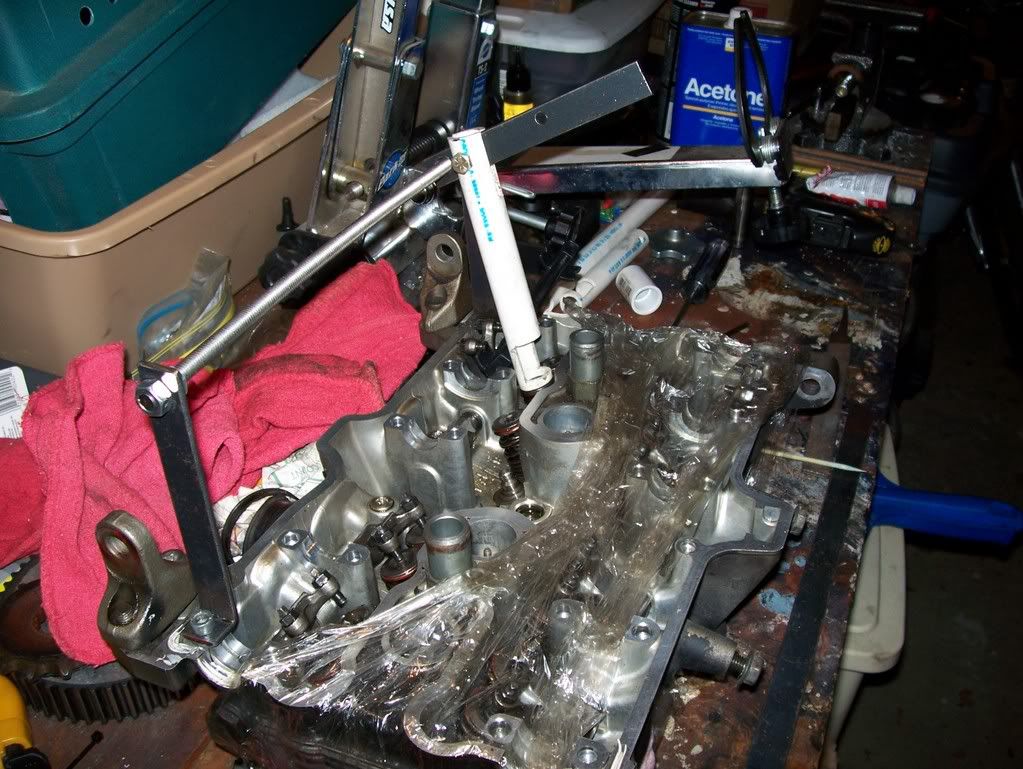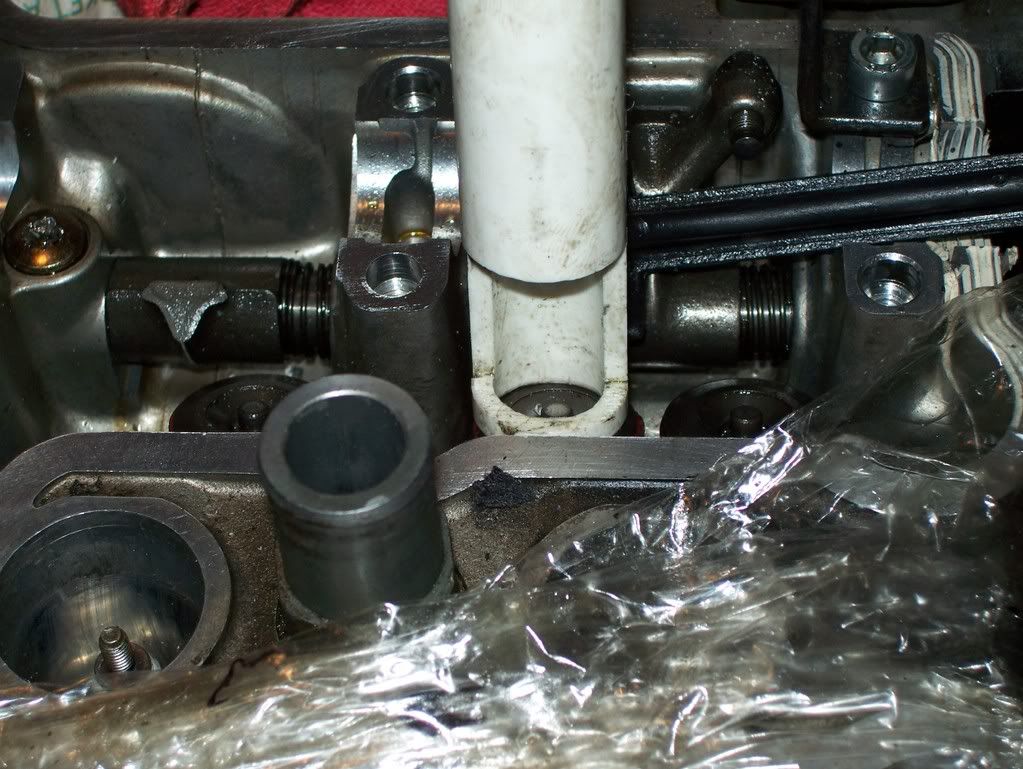**This is a more technical than a cam install and if you can't grasp that concept, have a shop do this for you.**
So many of you have been following the continuing saga that is my version of Jay's exhaust cam mod.
The truncated version is that it works great in my new-to-me motor but the new-to-me motor was a smoker. Thinking it may be rings, I decided to start taking apart my old motor to have the slugs ready to accept new rings and to get the cylinder ready to hone. Also, I would have to replace the stem seals as well seeing that there is no reason to not do it since everything else was coming apart.
Here's the rub:
-Rings: $29 x 4: $120
-Gasket set: Ebay is the cheapest at $130 and includes everything for the block and top end (including valve stem seals)
-Case gaskets: (the set doesn't come with these) $15 starter $8 clutch
This also doesn't include machining costs for checking the cylinder head and a valve spring compressor tool that works off the bike.
Now mind you, I'm already into this for $300 or so for the motor and I'm tired of hemmoraging money so I decided after examining the pistons from my other motor, that more than likely the rings sealed fine and it may just be the stem seals that need to be replaced. Signs were: Smokes at idle, leaving from a light, slight blueish-whiteish trail at part throttle. Basically at the highest vacuum moments, bad seals allow oil to seep down the stems into the combustion chamber: smoke.
Here's where it gets interesting: even the valve stem seals are expensive: $54 from Bike Bandit for 16 OEM seals. Coming from a car background, that is ridiculous. I usually spend less than $20 for 16 stem seals for my VW. Searching around only yielded slightly better prices but the least expensive place to get them was APE race parts. These are for a Honda 929 but they size out exactly the same: 4.5mm stem, 10mm deep x 8mm Dia (for the valve guide). $36 later and $10 shipping I was on my way. P/N is 99210.
Now, everyone I asked has told me that it is necessary to remove the cylinder head in order to do the stem seals. This is only partially true. Once again, coming from a car background, it isn't uncommon to do them while still bolted up on the block and in the vehicle but you do need a tool that will allow you to compress the valve springs in order to get to the stem seals themselves. This tool bolts to the cylinder head once the cams are removed.

The tool is basically two towers made up of 1/2" wide, 3/16th thick steel plate using a 16" piece of stainless steel 5/16th allthread. The piece used to compress the valve spring is made of 6 1/4" of 1/2" PVC with a notch cut out of it to access the keepers. I also used a bicycle fork packing piece to support the press against the rocker so that the pipe would not creep (since the entire valvetrain sits at a 15* angle or so). You can use anything you like, I had this and it worked fine for me.

It bolts to the head via the cam towers on the far sides using some metric hardware (6x1 IIRC). The towers stand at 5 inches high and have 6mm holes drilled into the bases for the mounting bolts. The lever itself used to be longer but I had to cut it down to 5.5" in order to have enough space to work with on the bike for both the exhaust and intake side. The tool is in position to do the exhaust valves in this picture, obviously it would need to be re-oriented to do the intakes.

Now obviously these pictures were taken on my messy workbench in the basement but this contraption does fit in the confines of the Bandit frame on the bike. Usually when you do this on a car, you fill the cylinders via the spark plug hole with air so that the valve won't drop in. The more old school way to do it was to fill the cylinders with rope or string to cushion the valve. I just worked on the cylinders in pairs at TDC since 1-4 and 2-3 are paired and gently rested the valves on the cylinder tops. If you've never seen them, the pistons are cast in the same angle that the valves are positioned in the cylinder head (hemispheically) so that the entire valve face is supported, not just an edge which could cause it to bend otherwise.
This is a very tedius job and not for the faint of heart. The keepers that hold the valves into the retainers are little chips of metal barely 2mm around (paired). If you don't properly support the tool as well as place some rags or a sponge down at the cavity of the cam chain, you may never find them again. Removing them sometimes takes a gentle rap with a wrench on the compressor to free them from the retainer and if the tool slips (reason for the support peice in pic 3) they will shoot to the neitherregions of everywhere. You'll need a magnetic pick-up tool (a small one) to remove them from the valve stem and a pair of long reach needlenose to remove the seal from the valve guide. The old seals may be cracked and brittle and will not want to come off but be careful that you don't scratch the valve stem in the process. Be sure to oil the new seals prior to installation, they should push right on and snap into place on the valve guide (has a shoulder for them). Also, make sure you only work on the cylinders that are at TDC. If you don't, you'll drop a valve and have to pull everything apart.
Total time from start to finish was 4 hours or so, a total surgery. Other tools you'll need are a non-magnetic poker of some sort (I used a bamboo barbecue skewer) to coerce the keepers back onto the valve stem (the hardest part). Make sure to also replace the springs onto their proper spots and orientation. I found it easier to work with the pair of valves at the same time just to allow more room for extraction of the seal.
Results: no more smoking. All of the seals on the exhaust side of my low-mileage motor were dry rotted and cracked probably due to the heat and tight valves. The intake side was much better. The irony is that my old motor's seals were all fine at 25k, the new-to-me motor had 7k. Go figure.
Best of luck and most importantly TAKE YOUR TIME.
-Randy